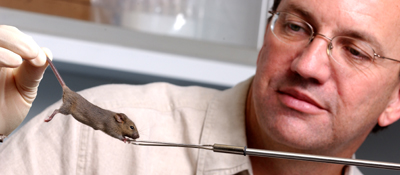 |
|
|||||||||
|
Of mice and genes Every week or so Chicago molecular biologist Brian Popko goes mouse hunting on the Web. He scans the databases of a half-dozen mouse mutagenesis centers across the country, searching for lab mice with intriguing neurological problems—say, shaky hind legs or weak forepaws. When one catches his eye, Popko turns to his research team: is this a mouse worth studying?
The researchers in Popko’s lab need mice whose dysfunctions parallel those of humans who have diseases of the peripheral nervous system—the system carrying signals from the brain and spinal cord to the limbs, skin, and internal organs. Peripheral nerve diseases are associated with problems ranging from hand numbness in carpal tunnel syndrome to loss of sensation in the feet of diabetics. Peripheral neuropathies are also linked to leprosy, malnutrition, autoimmune diseases such as lupus, exposure to poisons including insecticides, medications for cancer and AIDS, and infections such as Lyme Disease. Popko finds mice fascinating for the window they provide into molecular biology—a discipline that won his devotion when, as a 14-year-old, he read The Double Helix by James D. Watson, SB’47—but the researcher is also driven by the hope that his work will help those with peripheral neuropathy. “It’s a disease that is intellectually challenging, but it’s also clinically important,” says Popko, the Jack Miller professor in neurological diseases. Physicians who study peripheral nerve disorders don’t know precisely how widespread they are because the causes are diverse and misdiagnosis is frequent; a common estimate is that 20 million Americans are affected. In Popko’s lab researchers use neurological problems in mice as models for human ailments. By tracking down the gene(s) behind a mouse’s leg tremor or the frailty of its grip, the team hopes to learn how particular genes govern the cellular processes that allow mice to move muscles or regenerate nerves, to sense heat or feel pressure. Understanding basic functions in the mouse sheds light on the nervous system of humans, who, despite appearances, share a great deal genetically and physiologically with the mice delivered to Popko’s lab. Once a mouse arrives, the researchers make sure it’s worth their time: finding the mutant gene among the 30,000 to 50,000 normal mouse genes is a one- to two-year process, and the lab only studies six to ten mutant mouse strains at a time. As Popko explains, “Doing a detailed phenotypic analysis on an individual strain, as well as finding a single mutant base-pair out of 3 billion nucleotides, is a considerable task.” The team begins by confirming that a mouse’s neurological problems mirror those of humans, examining the mouse much as a neurologist would examine a person: measuring muscle strength, testing reactions to heat and cold, looking for abnormal gait, and evaluating nerve function. If the candidate proves clinically interesting, Popko and his colleagues breed the mouse and its offspring with normal mice from another strain with a distinct genetic background. Of the scores of mice born, about one in four will show physical or behavioral signs of the mutation. Using the genetic differences between the two parental strains, Popko’s group links the mutation first to one of the mutant mouse’s 20 chromosomes, then to a particular region of the mouse genome, eventually narrowing the field down to a single gene. Meanwhile, not far from the lab, the Medical Center offers clinical care for people with peripheral nerve disorders. The clinic, in the Duchossois Center for Advanced Medicine, is another division of the Jack Miller Center for Peripheral Neuropathy, which provides patient care and education while supporting basic research. The clinic recorded 500 patient visits in 2002–03, and the center’s Web site (millercenter.uchicago.edu/index.shtml) drew 5,700 visitors in August, just three months after it was launched. Established in May 2001 with a grant from Jack Miller, a Chicago businessman who suffers from peripheral neuropathy, the center is headed by Popko, whom Miller helped to recruit in January 2002 from the University of North Carolina at Chapel Hill. The patients being treated in the clinic understand the importance of basic research, says Popko, who occasionally reports new findings to patient-support groups. “Surprisingly, they have embraced our approach. They know they have a disease that we don’t know a lot about and that you don’t hear a lot about. You don’t see the cover of Newsweek devoted to peripheral neuropathy, although there are a large number of people who have it.” While he cautions that “we are in the early stages,” the pace of discovery has been fantastically accelerated by newly developed technologies and databases. These include techniques for sampling and characterizing the genes of mice (using cells taken from tail snips); the sequencing of the human and mouse genomes, both completed in the past two years; and gene microarrays, in which a computer simultaneously displays expression patterns of tens of thousands of genes from two mice, illuminating differences between patterns in mutant and normal mice. Though the discovery process remains painstaking,
the progress of the past few years was unimaginable when Popko completed
his doctoral research at the University of Miami School of Medicine
19 years ago. “If it were 1984 and I told you I was looking
for mutant genes in eight mouse strains, or even two,” he
says, “you would think I was overly ambitious—or even
insane.” Now, aided by mutant mice, Popko’s team may
help point the way to treating humans with similar peripheral nerve
diseases. The prospect, Popko says, is “exhilarating.”—Cathy
Shufro
|
|
Contact
|


